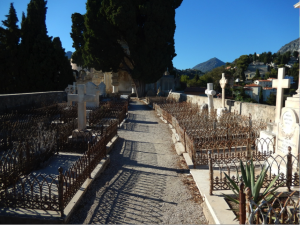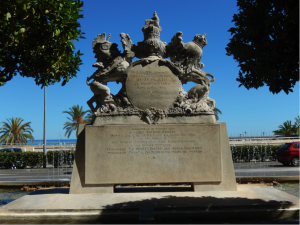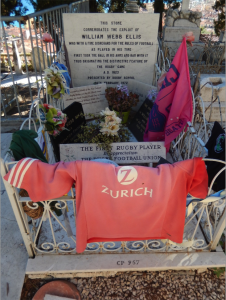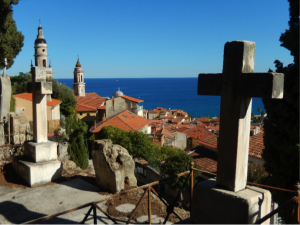UOB PhD student Gary Willis writes for us, below, on the Council for the Preservation of Rural England. Gary wrote his Masters dissertation on the role of British conservation organisations during the Second World War, and this forms the basis of an article about the role of CPRE during the war which is now published in the October 2018 issue of the Rural History journal. He is currently undertaking a PhD on the impact on the rural landscape of Britain’s expanded war industry in the Department of History (Historical Studies) at Bristol, supervised by Professor Peter Coates. Continue reading
Author Archives: victoriabates
‘The Maltese Soul’ and the Quest for a Post-Colonial Identity
During a recent visit to Malta, Research Associate, Dr Andrew Hillier, found a country seeking to establish its identity in the post-colonial world.
Save for the odd passing reference, Malta tends to go un-noticed in British imperial history. Yet, for over 150 years, the island, together with neighbouring Gozo, was an important British colony, playing a key role in the empire’s Mediterranean strategy. Moreover, when the country finally gained its independence, this ended not just British rule but two thousand years of colonisation. Its history, therefore, is instructive as to both Britain’s imperial project and, more generally, the impact of imperial rule on a nation and its people.
The Curious Creatures of Victorian Taxidermy
Our PhD student Alice Would (co-supervised with the University of Exeter) has had an article published in the History Today Miscellanies series. Her piece looks at ‘the exotic dead animals that appeared in the menageries of Victorian Britain’s grand exhibitions’. You can read more here. Congratulations Alice!
The Roots of ‘Springwatch’
BBC 2’s ‘Springwatch’ recently completed its fourteenth annual 3-week run. It’s become as much a part of the British spring as bluebells, wild garlic, frogspawn and ducklings. But it didn’t mushroom into success overnight. Environmental historian Peter Coates, who’s working on a project with the Bristol-based BBC Natural History Unit, has written a blog for the Arts and Humanities Research Council about the origins of this national institution: https://ahrc-blog.com/2018/06/14/how-springwatch-was-sprung/
CFP. Creative Histories
University of Bristol, July 19th -21st 2017
What does it mean for history to be creative?
This two-day conference explores the ways that educators, researchers, writers, artists, students, practitioners, and curators have brought the past to life, made history compelling, and had fun.
This is particularly important today. While public enthusiasm for history is as strong as ever, academic historians face currents of anti-intellectualism from politicians convinced ‘we’ are sick of ‘experts’, and even senior university officials who think ‘society’ does not need historians. Some academics, on the other hand, have jealously guarded the title of ‘historian’, leading to debates about professional identities, independent research, and popular history. Now, more than ever, is the time to explore the creativity of the many different types of history being produced in (and across) many different places.
We invite proposals for contributions including performances, recitals, demonstrations, research papers, and exhibitions addressing one or more of the following broad themes:
History in Public – History from and for below – Community histories and co-production – Museums and galleries – Interactive historical education – History publishing – The economics of public history
Historical (Non)Fiction – Novels – Poetry -Theatre – Journalism – Memoir and autobiography
Visual Histories – Photography, film, television – Art history – Curation
History and Social Media – Blogging – #twitterstorians – Digital humanities – #storypast
Proposals of 250 words for a single contribution should include the name(s) of contributor(s), the AV and technical needs and length of the contribution, and explain how it relates to the theme of ‘creative history’ and the sub-themes above. Grouped proposals for sessions of two to five contributions are especially welcome.
Deadline: 31st January 2017.
Please send proposals and questions to creative.histories.bristol@gmail.com.
Menton Memorials: Then and Now
On his travels again, Andrew Hillier finds evidence of British colonisation nearer home in the French Riviera resort of Menton.
In my last blog (Malaysian Linkages, Old and New) I examined how Britain’s presence in nineteenth-century Malaysia could be explored through its buildings, cemeteries and other spaces. Similar evidence of a British presence, albeit in a different context, can be found in Menton, the village, perched on an outcrop of the Mediterranean coast, which Britons began to frequent in the 1860s.
University of Bristol historian John Pemble’s, The Mediterranean Passion, published almost 30 years ago, remains the most engaging account of how the Riviera was colonised during this period, principally by Britons, Germans and Russians. As he shows, it was British doctors who, by ordering their patients to go south in winter, first transformed the region’s ‘humble French and Italian villages into fashionable winter resorts’.[1]
Nowhere was this process more evident than in Menton. If Dr James Henry Bennet (1816-1891) first put the medieval village on the English map, by recommending it for patients suffering from phthsis (tuberculosis), it was Queen Victoria who gave the resort its real impetus. She spent two months there in 1882, in search of a cure for her youngest son, the sickly Prince Leopold; sadly without success, as he died two years later.
Such was its attraction as a health resort that, by the turn of the century, invalids in ‘their Bath chairs monopolised the promenade du Midi by day and by night their premature retirement imparted a hospital hush to the atmosphere’.[2] By then, although multi-national, the French regarded it as ‘une colonie Britannique’. And although this was in part Gallic humour, it can properly be considered as part of ‘the British World’: of its seventy-five hotels, seventeen boasted Anglo-Saxon names, including Victoria, Windsor, Balmoral and Westminster, and, outside the old town, many of its Belle Ēpoque villas were owned or occupied by Britons, whose lush ‘English’ gardens cascaded down to the sea.
The more intimate setting of Le Cimetière du Vieux Chateau most obviously captures this presence. Multi-denominational, the marbled mausolea of French Roman Catholics greet you on arrival. Higher up the hill, the graves of those same invalids compete for the fabulous views which unfolded before the grieving mourners. Trusting in, but – alas – not cured by, treatments prescribed by Dr Bennet, they first started to be buried here in the 1870s. Plainer than the French graves, the simple stone slabs are each surrounded by a low gated fence – the only concession to the Mediterranean ambience. Evocative in their own right, they connect us with lives that, for all their luxury, ended, for many, in their early thirties.
It might be thought that these Britons, who spent their winters in Menton and other Riviera resorts, developed a more cosmopolitan outlook than their counterparts who stayed at home. The evidence is, however, against this. Most came in search only of the climate and a cure and had little interest in France or its culture, nor in associating with any of the other nationalities who wintered there. When they stayed in hotels, they held themselves aloof and when they rented villas, they brought their own servants to tend to their needs. If they had any interest in their surroundings, it was limited to classical antiquities. As Pemble concludes, in the years leading up to the First World War, the British ‘were never more insular than when they were abroad’.[3]
If this smacks of a typical colonial mentality, it would be wrong to suppose that it was resented then, or is so now. The resort is keen to celebrate what an official publication calls ‘la volonté Britannique de recréer un “bout d’Angleterre” partout où ils s’installent’.[4] Buildings and streets retain their English names: Rue Henry Bennett boasts a statue in his honour; Avenue Edouard VII runs in parallel to it; and, in 1960, an elegant fountain was installed in Square Victoria, as it is called, to commemorate the visit of that monarch’s mother.[5]
Not only is the foreign section of the cemetery well-maintained but public funds were also made available to restore the grave of a quintessential Englishman, even though he had not merited a mention in Pemble. If the Revd William Webb Ellis may not be the cemetery’s most celebrated incumbent, his grave is now certainly the most garlanded.
No indication is given as to why the Vicar of St Clement Danes, The Strand, was in Menton at the time, but, if, as seems likely, it was to convalesce, then as with so many others who came for that purpose, it was to no avail. A bachelor, he died on 24 January 1872 at the age of 65. Whether he did in fact pick up the ball and run and thereby found the game of rugby is controversial. However, plainly this does not trouble those who climb the hill to pay their respects and place their tributes on his tomb. Ranging from New Zealand to the Ukraine, they demonstrate how memorialisation can be a positive means of generating and reflecting international goodwill.
Surrounded by the graves of Britons, Russians, Germans and French, high above the bay known as Le Golfe de la Paix, the private memorial of one unassuming English clergyman provides a fitting space in which to ponder the fragile nature of international comity.
[1] John Pemble, The Mediterranean Passion: Victorians and Edwardians in the South (Oxford: Oxford University Press, 1988); quote at p.84.
[2] Pemble, p.87.
[3] Pemble, p.268.
[4] Francois Rosso et al., Menton rejoint la France: 1861, Chronique du Rattachement (Les Archives Municipales de Menton, 2011), p.58.
[5] The French always spell his name with two T’s, Pemble, following his BMJ entry, with one.
Remembering George Hare Leonard, 1863-1941
An institution is comprised of more than just buildings, hierarchies or symbols. When the University of Bristol was founded in 1909, its managers and patrons rushed to explain its purpose in terms of what it stood for: a common culture – an attitude – of excellence, improvement, and civic responsibility. But these are just fine words until they are given meaning by real people actually enacting these values, promoting and defending them.
Today – graduation day – is a very important day for University of Bristol historians. One of the ways we celebrate our students’ success is through the award of prizes for high attainment. The George Hare Leonard Prize is awarded to the graduate with the best overall performance, but who was George Hare Leonard, and what does the fact that we attach his name to such a prestigious award mean?
Born in Clifton, Leonard took his BA and MA in History at Cambridge, returning to Bristol to deliver the Cambridge Extension Lectures in the 1880s and 1890s. He was eventually appointed Lecturer in History at University College Bristol in 1901, rising to the rank of Professor in 1905. Only one one other candidate was interviewed for the professorial job: Frederick Maurice Powicke, who would go on to rise to the very top of his discipline by becoming Regius Professor of Modern History at the University of Oxford.
But Leonard was something special, and everybody at University College knew it. The College’s great patron, John Percival, the Bishop of Hereford, remarked in 1908 on the ‘good work’ that he and ‘the younger teachers’ were doing there. This stood in contrast, Percival claimed, to ‘older professors’ who had ‘lost touch with the working classes’. Leonard’s retention as professor came at just the right time to make a real impact, for in 1909 the College became the University of Bristol. At this institution Leonard stayed until his death in 1941.
There is much to celebrate about Leonard’s life, and his contribution to our institution, our discipline, and our city. Four highlights may serve to underline why he is worth remembering.
First, he used his professorship to reinvigorate the intellectual quality of historical studies at the College by introducing a new syllabus in the 1906/07 academic year. For the first time ever at Bristol, students were expected to become acquainted with primary sources directly, and to engage in a dialogue with their lecturers. Out went grand lecture series which tried to locate the greatness of the English psyche in the misty forests of fifth-century Saxony; in came the latest historiography, original documents, and a spirit of common intellectual purpose. These are the principles which still form the core of the degree at Bristol today, where our students are encouraged to form their own opinions, and to share and defend them in rigorous but collegiate seminars.
Second, he held a firm belief that the production of historical knowledge was an endeavor of real value, arguing that history ‘cast light on modern problems which engross the attention of all thoughtful men’. We encourage all our students to consider the purpose of what we all do and, whether we agree with Leonard or not, the willingness to engage in critical self-reflection is an important skill which we try to encourage all at Bristol to adopt. Above all we want our graduates to be self-confident in the value both of their discipline and of their own beliefs and ideas.
Third, he was strongly committed to the equality of all persons. While holding his professorship, he headed up a committee and acted as fundraiser-in-chief for the erection of a memorial to Mary Clifford, a nineteenth-century campaigner for women’s welfare, in Bristol Cathedral. This was neither an easy nor a meaningless gesture: in the 1910s, attacks on Suffragette headquarters in Bristol were widely reported in the national press. Leonard was a person willing to speak out, but perhaps more importantly, to put his ideas into action.
Fourth, he ‘gave himself heart and soul to the cause of adult education’, according to the writer of his obituary in The Times. This was an accurate assessment. Not only did Leonard frequently hold the management of the University to account on the issue of ‘educating the working men and women’ of Bristol, but he also gave up what little time he had spare to read their poetry, respond to their letters, or even go rambling with them – even if they were not registered students. At Bristol today, we celebrate continuing education and aspire to widen access as far as possible, because we see that education can have a transformative impact on peoples’ lives.
So, when we award the George Hare Leonard Prize today, we do more than just remember one of our department’s ancestors. We celebrate a great historian, certainly, but we also recognize a set of timeless values which bind us together – staff, students, and graduates alike. We celebrate both individual excellence and a collegiate spirit, the importance of rigour, but also the enduring value of historical thinking. In offering an award in Leonard’s name, we look not a committee to define our values for us, but to our own past.
Special thanks to colleagues in the University of Bristol’s Special Collections, who helped to identify some of the sources which form the basis of this judgment: Leonard’s own correspondence, that of the Bishop of Hereford, Calendars of the University College Bristol, and various newspaper cuttings.
Dr John Reeks, Teaching Fellow in History.
Time for History in a History Degree
Third-year undergraduate Tim Galsworthy reflects on a year of participating in ‘History at the Hawthorns’: a series of informal discussions with academics outside the seminar room.
Whilst undertaking a History degree at the University of Bristol we spend an awful lot of time doing history, but we spend less time thinking about history. What are we doing history for? Who are we doing history for? Is there even any point in doing history at all? These are some of the major questions we have been wrangling with during the History at the Hawthorns series. The History at the Hawthorns series has given us an informal setting to discuss all things historical. From topic specific sessions, such as one on the historical memory of the Easter Rising, to general sessions of big issues, such as the pursuit of truth in history, we have covered a great deal of material.
We reached general consensus on the importance of public history, a major topic of our discussions. In a world of diffuse moments, historical films, and even historical video games the past is omnipresent in our society. We debated the issues of ‘truth’ and ‘accuracy’ in public history, agreeing that academia needs to engage with the general populace. The issue of historical memory, especially physical reminders of the past, also drew our attention. The concurrent ‘Rhodes Must Fall’ campaign informed these debates. We argued that erasure of the past is just as dangerous as the celebration of imperialism. We argued for the historicising of artefacts, rather than their destruction. Once more we saw the importance of engaging in such public historical issues.
The make-up of our History at the Hawthorns group has been just as rewarding as the discussions themselves. Our group contained first, second, and third years, along with Masters students. A number of mature students also made up our group. It was extremely satisfying to discuss historical issues with a diverse assembly of people. Different ages, even different generations, from different backgrounds bring a great variety of views to the table. It is always worthwhile to hear competing opinions, sometimes opinions you never even considered, on such important topics. It is only through such interactions that we can grow as historians specifically, and as individuals generally. The interaction between students in different years is expedient in creating a greater sense of community in our school.
Praise must also be paid to the academics who took the time to lead these sessions. History at the Hawthorns allowed me to feel like a historian in training. The informal nature of the discussions allowed staff and students to discuss history as equal, coming from different perspectives and different predispositions. Just as talking with students from other years contributes to a more wholesome University experience, talking with academics enables students to consider themselves as junior academics in a shared scholarly community. As someone who wants to become an academic, but is currently still a student, the opportunity to look a major historical problems from both sides of the fence was an incredibly useful experience.
We spend so much of our University experience with our heads stuck in books, writing essays, and accumulating marks. History at the Hawthorns afforded us a casual vehicle to spend time just talking about history, without having to worry about exams or essays. It enabled us to really sit down and think about what history means, to historians as a collective and to us as individuals. There is nothing better than discussing history, over or a pint or a cuppa, with other people passionate about the past. Sometimes our degree gets so hectic – especially for third years like me – that we forget just how lucky we are to spend our time doing history. The History at the Hawthorns series has reminded me just how much I love history purely for the sake for it, rather than just as a degree subject. I would recommend students in future years take up the opportunity to partake in this series.
The Lost Workscape of Tyneside
Hunter Charlton, a 2015 graduate of Bristol University’s History Department, has made a film about the decline of industry on Tyneside in collaboration with the AHRC research project The Power and the Water.
Hunter also wrote a final year undergraduate dissertation on ‘Landscape and Change: Shipbuilding and Identity on the Tyne’, which you can read here: http://www.bristol.ac.uk/media-library/sites/history/documents/dissertations/2015charlton.pdf.
The Case of Father Bloodsucker
Our series by new lecturers continues with a piece by Will Pooley, Lecturer in Modern European History, who brings together his work on the histories of folklore and witchcraft with this blog on the strange case of ‘Father Bloodsucker’:
I’ve come across a few pretty weird cases in my ongoing search to find crimes involving witchcraft in France between 1791 and 1940, but perhaps none are stranger than the story of ‘Father Bloodsucker’ (Le Père Sangsue).
This is how the violently anti-clerical and republican newspaper La Lanterne told the story at the time:
The following events took place in a small village in the Gers, where there lived an ugly old man who had been dubbed Father Bloodsucker, who lived by a pond teeming with eels and leeches. But nobody dared to fish in the pond, which was considered bewitched!
Father Bloodsucker claimed to be a witch, exploiting the terror he inspired in order to extract food and tobacco from the local population.
But one local man, Jacques Drux, refused to give in, driving Father Bloodsucker out of his house with his cudgel. Father Bloodsucker decided to take revenge.
He managed to gain the trust of both Jacques Drux’s daughters. He made them believe that the Kingdom of Leeches lay under his pond, and that he himself was King.
Every month, he was transformed into a leech and would go to see his subjects. Underwater, there was a wonderful palace.
Finally, he told them that any girl who threw herself in the pond on the night of the full moon at midnight, will be turned into a mermaid, and become princess of the leeches.
Inspired by his words, the young girls, Jeanne and Madeleine, arrived one night, determined to take the plunge. Jeanne rushed in first. Madeleine was about to follow her, when she saw a terrible head grinning in the rushes nearby. Father Bloodsucker had therefore not turned into a leech at all!
Madeleine realized the horrible truth and ran away, mad with terror. The next day, the locals found the body of Jeanne, with hundreds of leeches attached.
The old rascal has not been seen since.
Several things immediately make me suspicious about this story with its strange Freudian undertones:
-The vagueness of the location. Newspapers tended to either report the exact location of witchcraft cases, down to the hamlet or street where events took place… or they would use anonymised details, and ellipses to draw a veil of privacy over personal tragedies.
–The apparent blind credulity of the rural population. This is largely inconsistent – no matter what the newspapers claimed – with how people actually behaved in accusations of witchcraft. Many participants were skeptical, empirical, and careful, but confessed confusion and dismay at events they did not understand. In the case of Father Bloodsucker, though, the entire local population supposedly falls for his deception, and the young daughter of Jacques Drux are particularly vulnerable. This discourse of female credulity and superstition was the stock in trade of anti-clerical publications like La Lanterne.
–The fairy elements of a hidden world where a humble outcast is actually king. The story sounds suspiciously like a folk tale. There are a whole set of tales where it tends to be heroes (rather than villains) who persuade their enemies to jump into lakes or rivers, claiming there are submarine realms where they can become rich. If crimes involving supernatural beliefs such as witchcraft were fairly common (there were often three a year mentioned in the national press), this is the first time I have seen any evidence of a crime based the fairy world in France. Perhaps there are similarities here to the famous case of the murder of Bridget Cleary in Ireland, but even that is quite different to Father Bloodsucker. Bridget’s murder had many of the features of intra – family conflict, misfortune, and ill-health that characterise witchcraft crises.
–The characterisation and motives of the protagonists. These all sound rather fanciful, and stereotyped, more like how urban writers imagined the moral conflicts of the countryside than how people there actually behaved.
And it turns out I am right to be suspicious.
Twenty five years before this story appeared in La Lanterne, the Beaumarchais theatre in Paris briefly hosted a piece called ‘Le Père Sangsue’.
I have had a quick look through library catalogues, and cannot find any evidence of a script for this show, but it may well be that this was the kind of light (?) entertainment that leaves little trace in the archives. If any does know anything about this show, or about the Beaumarchais, I’d love to hear more.
But is that the end of Father Bloodsucker?
My research is about the very real conflicts that French men and women engaged in over sorcery in this period. The story of literary representations of witchcraft during the same era is in many senses a completely different one, which Vincent Robert has begun to tell.
Or is it?
I can speculate about why La Lanterne chose to present a story that was almost certainly fabricated as if it were true. Perhaps they were simply passing on a badly researched legend, which may have come from the theatre piece, or may have been the inspiration for both the earlier theatre piece and the newspaper story itself.
Or perhaps they were making a point about the credulity of the French population. La Lanterne was very fond of referring to the Catholic priesthood in the same terms most other newspapers reserved for the fraudsters, magicians, and magical healers hauled before the courts in this period. Perhaps Father Bloodsucker was meant to be read allegorically?
Whatever the case, it seems important to me that this story could be presented as if true, because it suggests I have to be careful whose truth I am dealing with when looking through the newspapers. Did readers think this story was true? Might it have fed back into their own beliefs about the creepy old men who lived near their houses?
How to draw a firm line between fact and fiction?







